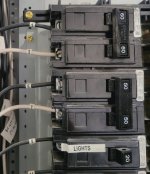s-park-er
Member
- Location
- Oroville, CA
- Occupation
- Building mechanic - specialty problem-solver.
So I have been helping a friend of mine with a commercial historic building, rewired by a local contractor with a very good reputation. While troubleshooting some dead receptacles, I found this:
 Similar on the opposing side but both are 50A. Those are 10AWG solid in MC cable.
Similar on the opposing side but both are 50A. Those are 10AWG solid in MC cable.
They are supplying four HVAC units (large ducted mini-split type, so both OSU and air handler).
I told the owner this is a problem that he should hold the contractor to. Owner told me that contractor says this is correct.
Where - outside of Never Never Land - would this be appropriate?
 Similar on the opposing side but both are 50A. Those are 10AWG solid in MC cable.
Similar on the opposing side but both are 50A. Those are 10AWG solid in MC cable.They are supplying four HVAC units (large ducted mini-split type, so both OSU and air handler).
I told the owner this is a problem that he should hold the contractor to. Owner told me that contractor says this is correct.
Where - outside of Never Never Land - would this be appropriate?

